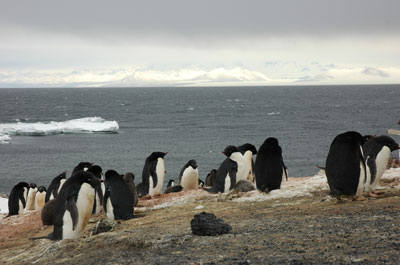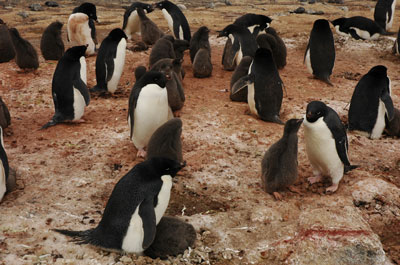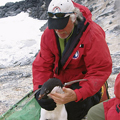No Sea Ice in Sight
CAPE ROYDS, ANTARCTICA– Since coming back from Cape Bird it’s been very gray and windy here at Cape Royds. It has been blowing 20 knots at least, and often the wind has been much stronger. Climate change predictions or realities, I know, are totally abstract to the vast, vast majority of people or at least those in the US. But, increased winds have been projected for the Southern Ocean and so, folks, I’d like to report to you that the predictions have come true. Next, a neighborhood block close to you. What predictions have been made for your region?
One result of the wind is that now there is no sea ice in sight. Well, except for on the south horizon. I can just make out the edge of the fast ice, which has receded by about 15 km since we arrived here in Nov. At that time the edge of the fast ice was 2 km north; now its that far south. Here’s a shot to compare with a photo in my earlier collection. The only sea ice off Cape Royds is a piece stuck on a low-lying rock. The penguins, of course, are loving it. They are traveling easily now, no walking required.

The open sea.
On the 1st of January the waters off Royds were invaded by at least 30 minke whales, and perhaps more. A helo pilot who had been flying along the edge by chance figured there were 40-50; he had a better view than me but I’m not sure what his experience in whale counting might be. There were lots. Besides the fact that they were diving under the fast ice, a few at a time, thus making it difficult to keep track of individuals, it was also hard to count them because it was blowing about 40 kts. Thus, the spray from their ‘blows’ was dissipating rapidly. The penguins, lined up along the ice edge, 1000 or more of them, and I think were a bit disbelieving or wondering what was going on. Well, what was going on was the whales were eating the penguins out of ‘house and home’ so to speak. Their trips to/from their nest became longer, and they started to bring back fish.
The whales in those numbers were around for two days, moving farther west along the ice edge as time progressed. Then they departed. About 5 days later, the penguins’ food switched back to krill. And they started to show up with very full bellies of food for their chicks. For several days, I got the impression that the chicks we’re getting all the food they wanted. Now they are, and the ground around the penguin nests is becoming red. That’s from the color of their poop, after a diet entirely of krill.

The red snow.










David, I think you are doing some amazing work. I hope u are well and look forward to hearing more about your research.
Dave, your work is thought provoking and most interesting.
Thank you. In a world where most people aren’t consciously aware of the effects of global warming around them, it’s important to realize that some of us see climate change manifestations every day. Some of the earth’s creatures are struggling hard to try and adapt.
I think this is sooo crazy